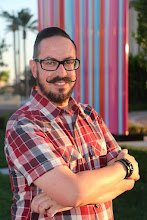There's a Lot of Holes in the Desert
People have been digging holes in the desert as long as they've been coming here. Nevada's nickname "The Silver State" comes from the state's mining industry. And as the mob's casinos became more successful, they would make deposits back into the desert, planting competitors and cheaters alike.
Artists have also seen the desert as a canvas, and Nevada and other desert states have been used for many earthworks. Michael Heizer used the desert of his home state and in 1969 cut two huge swaths in a mesa near Overton, Nevada, calling the piece "Double Negative." For over three decades, he has been working on a colossal city of earthworks, not yet in a complete form. A copy of the New York Times article, Michael Heizer: A Sculptor's Colossus of the Desert, details the scope of his ambitious project, with photos of the city's impressive scale.
But, as first noted in the Las Vegas Mercury and covered in Tyler Green's Modern Art Notes, the future of the project is in jeopardy. Yucca Mountain's railway system looks to skirt the huge city, and is seen by the artist as an unworkable intrusion on the project. The Mercury reports his response, "Needless to say, the not-so-friendly artist wasn't pleased to hear that a nuke waste railroad line was planned for the outskirts of his land. He told his neighbors that if the Caliente Corridor becomes reality, he will use his bulldozers to completely bury the City project and that he will walk away from it, in the belief that noisy trains will destroy the whole vibe."
This project is 33 years in the making, and to see what the world would be missing, you just need to view the photographs.
While Heizer may end up destroying the city he built, down in Arizona James Turrell is transforming his privately-owned meteor crater into a massive sculptural landscape. Unperturbed by development out of his control, Turrell is taking his crater as a means of realizing the transformational power of awe.
"People talk about spiritual in art, and I think that's been the territory of artists all along. You know, if you into the great cathedrals made by architects and through the light of artisans, you have created a sense of awe that often is greater than what people feel when they read, or any sort of rhetoric by the priesthood. This is something that can be very powerful in a visual sense."
















































<< Home